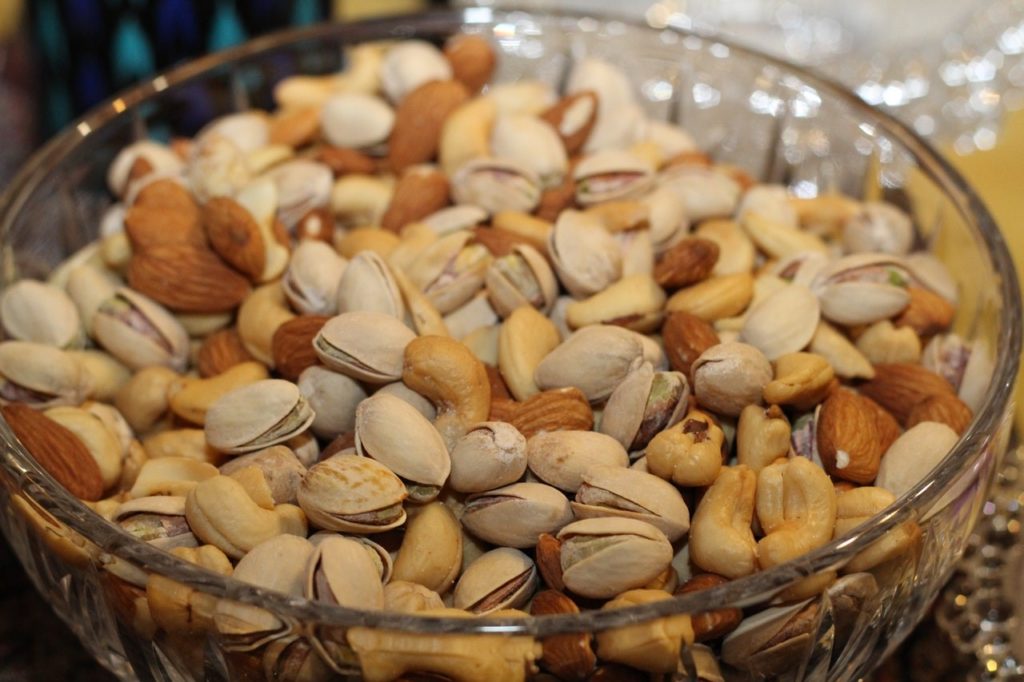
I learned this today. A nut is a hard-shelled pod that contains the fruit and a seed.
The difference between a nut and a seed is the hard outer shell. A seed is an embryonic plant. It contains protein, vitamin B, minerals, fat, and dietary fiber. These are all of the things that the seed will need as it grows into a new plant. Nuts also contain protein, minerals, vitamins, and fat, but they also have a hard shell. The seed is inside this hard shell. Nuts are formed when a fertilized flower’s ovary wall swells and hardens.
When a seed is planted, it starts to absorb water from the soil and it expands as it does so. The seed coat cracks open and the seed begins to grow into a new plant. The shell of a nut is too hard for this to happen, and this is precisely why they have evolved this shell.
The hard shell of the nut has evolved to allow the seed to survive through the cold winter and be ready for the spring. A lot of trees that drop nuts require a specific climate to grow. The shell takes a few months to soften in the earth, allowing it to weather the cold and wait until the climate is right. The shell will have softened enough by the spring for the seed to start to germinate.
Another reason for the hard shell is that the nuts need to survive in case of fire. Some nuts don’t start to germinate for over a year and the chances of there being a forest fire in any single year are high. Being fireproof gives the nuts a greater chance of surviving and germinating.
A third reason is that a hard shell gives animals a chance to scatter the seeds. Animals that eat seeds, eat the fruit there and then. Animals that eat nuts, like squirrels, gather them up and hide them to eat later. They generally bury them in the ground, at just the right depth for the nut to soften and grow. Studies have shown that squirrels forget where over half of their stores are buried, giving the nuts the time they need to soften and start to grow in the following spring.
There is a lot of confusion about what exactly a nut is and many of the things that we think are nuts, are actually not nuts. It is easy to get confused but all of the things that we call “nuts” can be separated into “nuts”, “drupes”, or “legumes”. So, what is the difference?
A nut, as I have said, is a hard-shelled pod that contains the fruit and the seed of the plant. The shell does not open and scatter the seed. Brazil nuts, chestnuts, hazelnuts, and acorns are all really nuts.
Peanuts are legumes, not nuts. A legume is generally the fruit or seed of a plant in the Fabaceae family, and they grow in pods. Peas and beans are in this family. The peanut is more closely related to the pea than it is to a nut. Hence its name, I guess.
Drupes are a type of fruit that have an outer fleshy part around the shell and the seed is inside that shell. Most of the time, we eat the fruit and discard the shell because we cannot eat it or it doesn’t taste good. Plums, peaches, and olives, for example. However, sometimes we discard the fruit and eat the shell. Walnuts, almonds, pecans, cashews, coconuts, and pistachios are all drupes. They grow with an outer, fleshy fruit around them and we discard that fruit and eat the shell and seed.
Whether they are true nuts, drupes, or legumes, “nuts” have a lot of nutritional value. They contain fats, proteins, vitamins, and minerals and can be good as part of a healthy diet. However, because they are small, it is very easy to eat a large amount of them.
Nuts have become a mass-produced agricultural product and the most consumed nut worldwide is the coconut. 62.5 million tons of coconuts are produced every year. Peanuts are second, with 49 million tons.
Nut farming on such massive scales can be harmful to the environment, but it is less so than meat farming. It takes a lot of water to grow nuts, with pistachios using the largest amount. It requires about 5,000 liters of water to grow 500g of pistachios.
So, nuts are a seed that has a fruit around it and a hard shell around that. Their shells are tough so that the fruit and seed can weather a winter in the ground. Many of the things that we think are nuts are actually drupes or legumes. And this is what I learned today.
Sources:
https://www.gardeningknowhow.com/edible/nut-trees/general-nut-care/seed-vs-nut-vs-legume.htm
https://en.wikipedia.org/wiki/Nut_(fruit)
https://www.seriouseats.com/what-are-the-differences-between-nuts-and-drupes
https://www.theguardian.com/science/blog/2016/nov/10/hips-haws-and-drupes-when-is-a-nut-not-a-nut
https://www.pexels.com/photo/white-yellow-and-brown-peanut-on-clear-glass-basin-86649/
https://boards.straightdope.com/t/how-do-nuts-germinate-in-the-wild/511969/10
https://88acres.com/blogs/news/water-footprint-of-seeds-vs-nuts
